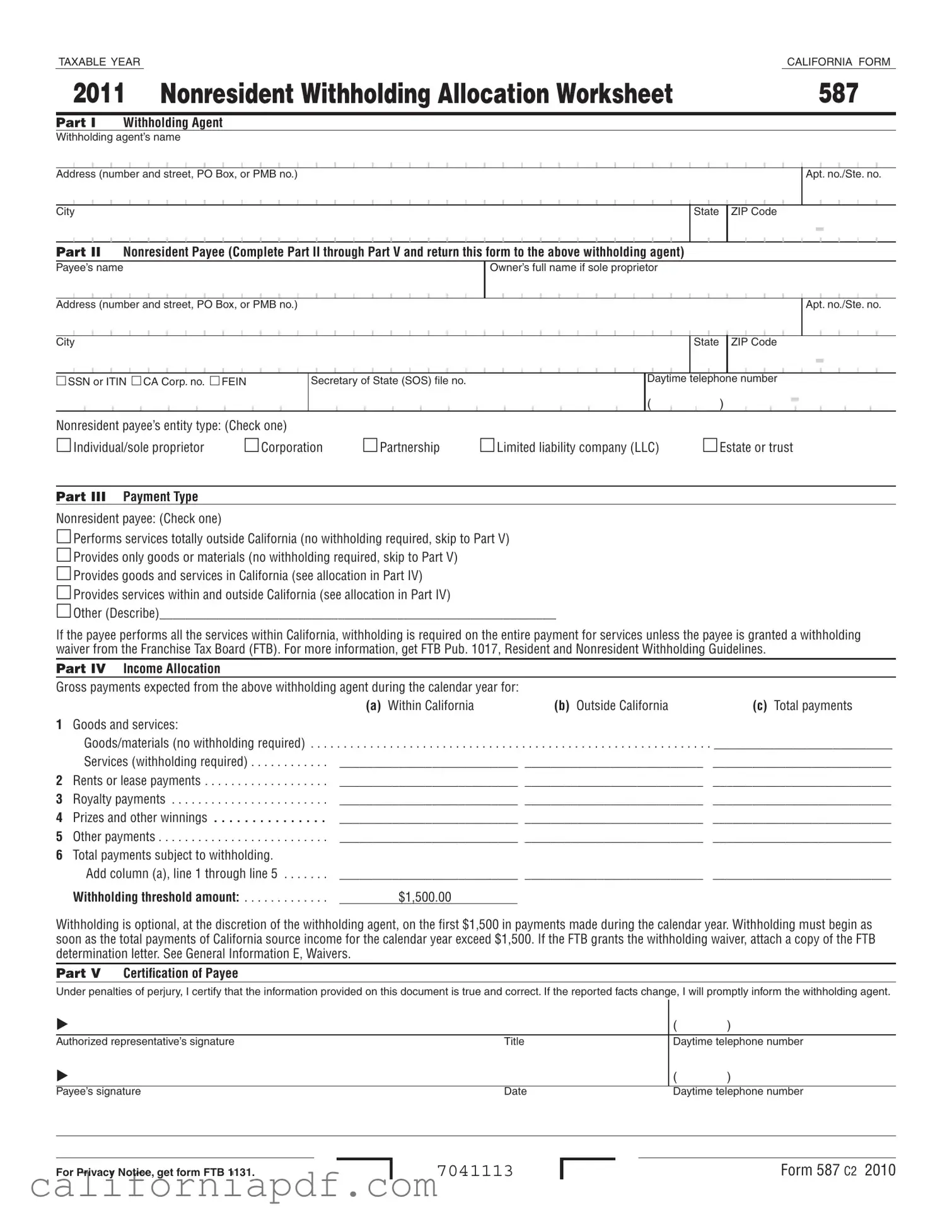The California 587 form, a Nonresident Withholding Allocation Worksheet, shares similarities with the Form 593-C, Real Estate Withholding Certificate. Both forms are essential for managing withholdings in California, yet they cater to different transactions. While the 587 form focuses on nonresident payments for services, the 593-C form is specific to real estate transactions, ensuring appropriate withholdings are applied to payments made to nonresident sellers of California property.
Form 590, Withholding Exemption Certificate, is another document with similarities to Form 587. Form 590 is used by individuals or entities to certify their California residency or exempt status, thereby negating the need for withholding on payments. Such a form contrasts with the 587 form, which primarily addresses nonresident withholdings. Both ensure compliance with state taxation laws but from opposite statuses of residency.
The Nonresident Reduced Withholding Request, known as Form 589, serves a similar purpose to the 587 form by addressing withholdings for nonresidents. However, Form 589 specifically allows nonresidents to request reduced withholding rates, compared to the 587 form's broader scope of allocating withholding amounts based on the payment's connection to California activities.
Form 588, Nonresident Withholding Waiver Request, parallels the 587 form as both are used by nonresidents in relation to California source income. While Form 587 helps determine the appropriate amount to withhold, Form 588 can be used to request a complete waiver of withholding, offering a potential path for nonresidents to avoid withholding altogether under specific conditions.
Form 594, Nonresident Withholding Annual Return, and the 587 share a link through the withholding process on payments to nonresidents. Form 594 is used to report and remit withholdings for the year, essentially summarizing the outcomes of individual transactions that might have initially been detailed through Form 587 worksheets over the tax year.
Form W-9, Request for Taxpayer Identification Number and Certification, while a federal form, operates in a complementary fashion to the California-specific Form 587. Form W-9 is often used to collect the taxpayer identification number (TIN) necessary for reporting payments to the IRS, similar to how the 587 form might gather such details for state-level withholding and reporting.
The Backup Withholding form from the IRS showcases a parallel function to the state-level Form 587. Both forms address withholding requirements, albeit in different jurisdictions. Backup withholding at the federal level ensures taxes are collected on certain payments, akin to how Form 587 regulates withholdings on nonresident payments for California source income.
Form 1099, a series of IRS documents for Miscellaneous Income reporting, intersects with the purposes behind Form 587. The 1099 forms report various types of income to recipients and the IRS, which may include payments subject to California withholding per the guidelines established in Form 587, illustrating how federal and state tax obligations often overlap.
Form 541, California Fiduciary Income Tax Return, bears relevance to Form 587 in contexts where trusts or estates make payments to nonresidents. While Form 541 deals with the income reporting and tax liabilities of fiduciaries, Form 587 might be used to determine and process withholdings on payments those entities make to nonresident beneficiaries or contractors.
Form 100S, California S Corporation Franchise or Income Tax Return, relates to Form 587 from a corporate perspective. S corporations might use Form 587 to manage withholding on payments to nonresident shareholders or independent contractors, ensuring adherence to state tax laws similarly to how they report their income and franchise tax obligations through Form 100S.



